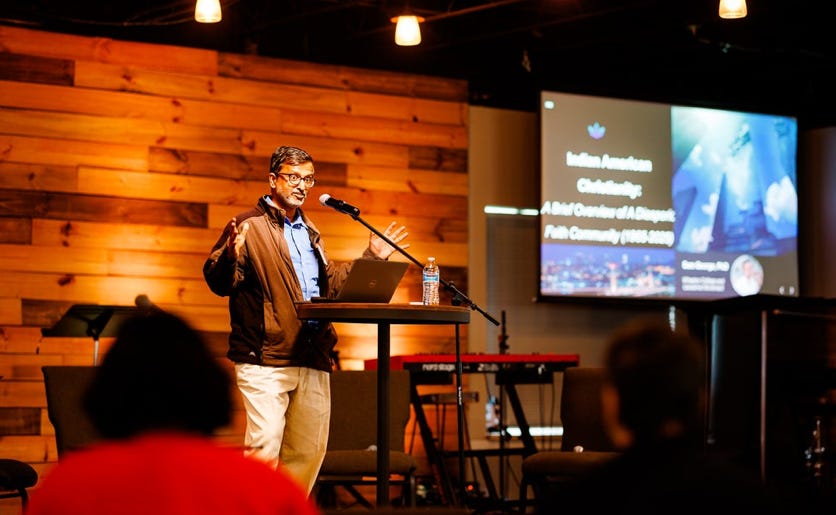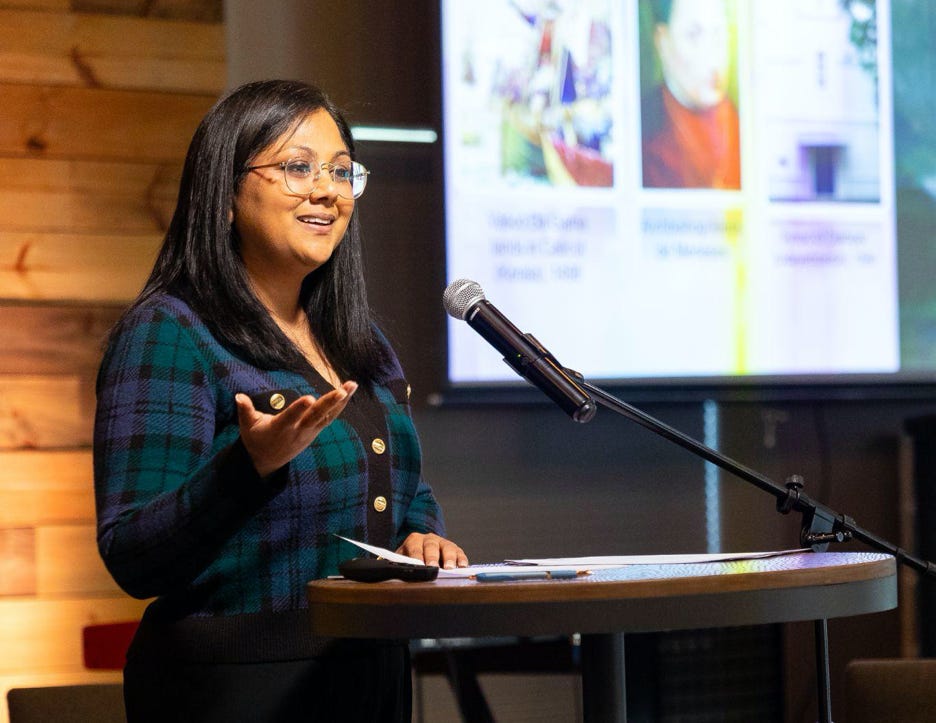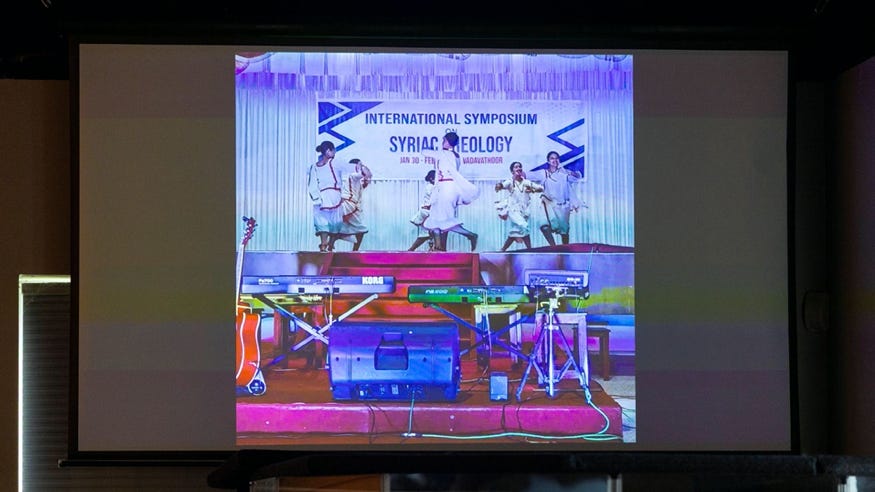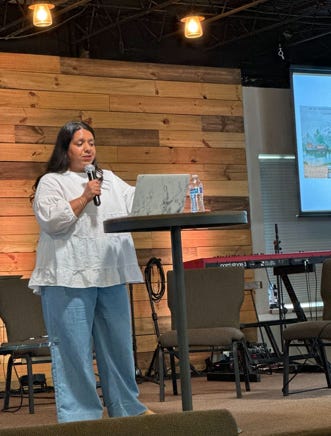Standing in Solidarity with St. Thomas Christians
The Power of Sharing Stories from South Asia and Beyond
By Fiel Sahir, Community Resourcing Catalyst with Asian American Christian History Institute (AACHI) housed at Fuller Seminary.
This photo essay is being co-published here on Imagine Otherwise and Pearl Dive as a collaboration between the Center for Asian American Christianity and Asian American Christian History Institute.
What would the world look like if we knew the stories of those outside our immediate reach? What power would we have if we knew our own? What if the languages we spoke and the way we look didn’t have to be a barrier to human connection?
It is my sincere belief that this conference invited us to imagine otherwise.
This past June 6-7, Our Story, Our Faith: South Asian American Christian Histories and Futures was held in collaboration with CAAC-Princeton Theological Seminary, the Asian American Christian History Institute at Fuller Seminary (AACHI), Epic Movement, and the American Baptist Home Mission Society hosted at Seven Mile Road Church in Philadelphia, PA.
We heard from theologians, storytellers, content creators, pastors, and more. Stories of real people came to life through panel discussions, plenaries, and in-person discussions in real time.
Growing up in Elmhurst, Queens as the son of an Indonesian American Baptist pastor came with its perks. One of them was being exposed to fellow Christians in their separate communities throughout New York City. I might attend an Indonesian church on Sunday and then be whisked away on Friday night to an Indian Christian small group where we would sing in Hindi to the beats of Indian percussion. From an early age, being in the company of Christians from around the world was part of my spiritual formation.
On a personal level, without India (and South Asia on the whole), I cannot be an Indonesian. My middle name is Mahatma and I share Gandhi’s birthday. My being is deeply intertwined into the legacy that has connected us historically through centuries of trade and cultural exchange. I believe being in proximity to other groups of people—Christians and non-Christians alike—is a way to temper our sense of reality and the convictions we hold most dear.
Case in point: my very first Santa Claus was a Telugu uncle from Andhra Pradesh in South India.
When most people in the US think of Asia, they think chopsticks, karate, and bubble tea. The Asian American narrative is heavily centered around East Asian American symbols and stories. This means that people like myself of South East Asian descent or my friends of South Asian descent have stories that often don’t make it beyond our own doors.
Ironically, across the pond in the UK, the word Asian often refers to people from South Asia because they were the first immigrants to arrive from the continent of Asia. But in the US, few know that South Asia generally includes nations like India, Pakistan, Bangladesh, Nepal, Sri Lanka, Maldives, Bhutan, and Afghanistan. And even fewer would know what to make of an off-hand comment that Sam George made about how the geographical category of South Asia was created by the CIA and isn’t even necessarily rooted in history.
If the American imagination has little room for South East Asians or South Asians, it has even less space for their Christian faith and witness.
How do we push back against these prevailing norms?

The Story of St. Thomas Christians
At the Our Stories, Our Faith conference, in-person and online participants learned of a people from the western part of Southern India who, thanks to St. Thomas, have been Christians for 2000 years. How? According to tradition, St. Thomas arrived in India in 52 AD and began his ministry amongst the people there. With their ancestral homeland rooted in the state of Kerala on India's Malabar Coast, the St. Thomas Christians emerged from the ethnic Malayali group.
The unique flavor of Christianity that they developed was not received well by visiting newcomers. Ironically, this would bring cognitive dissonance to the Portuguese who arrived on Kerala’s Malabar Coast in the mid-1500s. Their interactions with the St. Thomas Christians were far from pretty. As Dr. Jaisy Joseph of Villanova University explained in her plenary talk, the Portuguese found much of what they witnessed to be heretical and, at the Synod of Diamper, burned many of the ancient theological and liturgical literature that had been safeguarded for centuries. What they didn’t burn was taken to Portugal only to burn from the effects of the 1755 Lisbon earthquake.
In the eyes of the Portuguese, being Christian wasn’t enough. Allegiance to Rome and, in this case, submission to their Portuguese representatives was paramount. St. Thomas Christians were seen to be too Hindu in their practices and too connected to what was perceived as heretical Nestorian teachings from Middle Eastern Christianity.
This antagonistic posture towards St. Thomas Christians cannot be separated from the importance of the Malabar Coast’s pepper and cinnamon to the booming spice trade. Any decisions were deeply influenced by the Portuguese colonial powers and their attempts to ward off the Dutch, English, and French for the sake of empire. It’s interesting to note that, according to Dr. Joseph, it could said that the St. Thomas Christians had been one unified church up until this point and that an effect of colonization was to split people into Catholic and Orthodox streams and eventually Protestant forms of the faith.
One could argue that this is still seen in many parts of Christianity today. Thus, the saga continues.
To be sure, over the centuries, there has been increased diversity amongst Christians from Kerala. A range of denominations have developed—from the Jacobite Syrian Christian Church, Mar Thoma Church, Syro-Malabar Catholics, to various Pentecostal denominations. Not only did Dr. Joseph touch on the various relationships between them (or lack thereof), but she also addressed the subsequent intergenerational trauma that has been passed down.
She powerfully illustrated these dynamics by inviting the audience to consider the potential conflict that could arise if someone from a Pentecostal denomination dated someone who was Orthodox. When children of immigrants would ask where and how the taboo against such inter-denominational relationships came about, there would not be so much of an answer as an expectation that it not to be questioned and simply accepted as the taken-for-granted practice in Kerala.

In high school, I encountered St. Thomas Christians for the first time. But, my worldview at the time wasn’t big enough to know what to do with their existence. Sure, they had last names like Benjamin but my teenage self would have asked, “What in the world is an Orthodox Christian?” It is only recently that I’ve been learning how St. Thomas Christians made their way to the United States in the first place.
Dr. Sam George of Wheaton College provided an overview of the history of Indian migration to the US as well as demographic data on the concentrated locations of residence within the country. He noted, for example, that Philadelphia was and still is one of the first and most important communities of people from Kerala in the United States.
While the 1965 Immigration Act was the catalyst that allowed many Asian Americans to migrate to the US in the first place, Dr. George explained that many Malayali women came along with other groups of Asian Americans like Filipinos to fill the US need for nurses in the 1960s and 1970s. Of course, there were always exceptions. His mother-in-law, for example, came to the US as a student to study in Kentucky during the 1950s long before Malayalis were able to immigrate en masse.
In sharing this story, Dr. George demonstrated a key point: While trends and demographics are essential to understanding Indian migration to the US, it is important to remember that the experiences and legacies that form these histories are deeply personal as well.
What To Do With Our Stories
One of the highlights of our time together was having access to voices of creators and storytellers. The first panel discussion, “South Asian Storytellers,” featured oral historian Sherry Thomas, social media influencer Alex Thomas, and documentarian Shainu Thomas. What a gift it was to hear directly from storytellers who share the stories of their peoples so that we can all better preserve them for future generations! Their commitment to highlighting the stories of those who have gone before them was inspiring, especially when they shared about how their work impacts their own journeys of faith.
For some, the stories we heard may simply have been new. For others, the stories may have been difficult to hear and hard to process. A saving grace at the conference was that we were not left to struggle on our own! Sandhya Oaks, an Indian American adoptee, spiritual director, and ministry leader, walked us through her personal story and offered a framework called “Story Work” for processing difficult stories. The goal of Story Work is to facilitate healing and freedom for everyone and their inner world. History is not for the faint of heart. In discovering the past, we may have to deal with the implications for the present and the future, but they are where Jesus often invites us to be.
The conference was a special place where we were able to find kinship in our mutual love for Jesus. Speakers told stories of how St. Thomas Christian aunties and uncles would gather the family for early morning prayer. As Koreans related their own experiences with morning prayer, it brought fresh realization that different Christian groups often shared similar faith practices.
It is worth mentioning that only a slice of who can be considered South Asian Christians were featured at the conference. There was recognition that Dalit Christians, Nepali Christians, Bengali Christians, and Northeast Indian Christians may not have been adequately represented. Hopefully, this acknowledgment paves the way for future collaboration and connection throughout the Christian world.
As an Asian American who is a descendant of Austronesian peoples and East Asians it is my hope that Asian Americans can continue showing up for each other. I see a world where we sit at each other’s feet and glean from the wisdom accumulated from our respective cultures. As we learn from each other, we can know ourselves better. We can fight the good fight for the Kingdom and for the King. I want to imagine otherwise.
Even if the world presumes at first glance that we are as different as different can be, this conference showed that there is so much beneath the surface. We have more in common than we often realize and there is beauty in living in harmony together. As the Psalmist writes: “How good and pleasant it is when brothers live together in unity!”
Fiel Sahir is an Indonesian American social worker (LMSW) of historically multiethnic heritage hailing from New York City where he lives with his wife, a Dominican Nicaraguan American and fellow New Yorker. A multifaceted soul, he holds Master's degrees in Classical Music, Biblical Studies, and Social Work. Fiel currently works as a Community Resourcing Catalyst with Asian American Christian History Institute (AACHI) housed at Fuller Seminary. He also speaks multiple languages including Indonesian, French, Spanish, German, and Italian.















